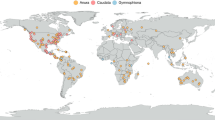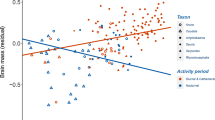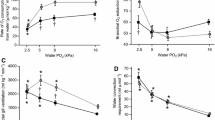Summary
-
1.
Maximal oxygen consumption rates (\(\dot V_{{\text{O}}_{\text{2}} } \) max; units, ml/g·h) were determined for four species of amphibians representing four families with habitat preferences varying from aquatic to terrestrial. Measured\(\dot V_{{\text{O}}_{\text{2}} } \) max were:Xenopus laevis (aquatic), 1.33±0.16;Rana pipiens (semi-terrestrial), 0.54±0.10;Bufo cognatus (terrestrial), 1.91±0.26; andScaphiopus couchii (terrestrial), 1.91±0.26.
-
2.
In order to assess possible cardiovascular bases for these interspecific differences, heart rate increments (differences between resting and active heart rates) and ventricle weights were measured to evaluate differential cardiac outputs. In order to assess possible differential blood oxygen capacities, hematocrits and hemoglobin concentrations were measured. Blood volumes were determined to assess total blood oxygen storage capacities.
-
3.
Ventricle weights were statisticaly significantly different (p<0.01) between all species,B. cognatus>S. couchii>X. laevis>R. pipiens. These differences were closely positively correlated with the maximal metabolic rates of the species (Fig. 3a).
-
4.
There were no differences in heart rate increments between the four species (Fig. 2).
-
5.
Blood oxygen capacities were directly correlated with hemoglobin concentrations (Fig. 1). There were no interspecific differences in the amounts of oxygen bound per gram of hemoglobin (1.3 ml O2/g Hb). Blood oxygen capacities were significantly different in the following sequence;X. laevis >S. couchii andB. cognatus>R. pipiens.
-
6.
X. laevis had statistically significantly greater hematocrits than did the other three species.R. pipiens had significantly lower mean corpuscular hemoglobin concentrations.
-
7.
Blood volumes were statistically significantly different between all species examined,S. couchii>B. cognatus>X. laevis>R. pipiens.
-
8.
It is suggested that greater maximal oxygen consumption rates in anurans are correlated with 1) increased cardiac outputs based upon increased stroke volumes, 2) increased blood oxygen capacities due to either increased mean corpuscular hemoglobin concentration or increased hematocrit. Increased selective pressure for aerobic metabolism is also closely positively correlated with maximal blood oxygen storage capabilities.
Similar content being viewed by others
Abbreviations
- MCHC:
-
mean corpuscular hemoglobin concentration
References
Andersen, H.T.: Physiological adaptations in diving vertebrates. Physiol. Rev.46, 212–243 (1966)
Astrand, P.O., Cuddy, T.E., Saltin, B., Stenberg J.: Cardiac output during submaximal and maximal work. J. appl. Physiol.19, 268–274 (1964)
Becker, B., Rathscheck, W., Rathscheck, H., Muller, H.K., Schroeder, W.: Sauerstoffdruck, Sauerstoffverbrauch und Durchblutung in der Extremitätenmuskulatur des wachen Frosches. Pflügers Arch.321, 15–33 (1970)
Bennett, A.F., Licht, P.: Relative contributions of anaerobic and aerobic energy production during activity in amphibia. J. comp. Physiol.87, 351–360 (1973)
Czopek, J.: The vascularization of the respiratory surfaces of some Salientia. Zool. Polon.6, 101–134 (1953)
Czopek, J.: Vascularization of respiratory surfaces inLeiopelma hochstetteri andXenopus laevis. Acta anat. (Basel)25, 346–360 (1955)
Gahlenbeck, H., Bartels, H.: Temperaturadaptation der Sauerstoffaffinität des Blutes vonRana esculenta. Z. vergl. Physiol.59, 232–240 (1968)
Hall, F.G.: Hemoglobin functions in the blood ofBufo marinus. J. cell. comp. Physiol.68, 69–74 (1966)
Harris, J.A.: Seasonal variation in some hematological characteristics ofRana pipiens. Comp. Biochem. Physiol.43A, 975–989 (1972)
Johansen, K.: Cardiovascular dynamics in the amphibian,Amphiuma tridactylum. Acta physiol. scand.60, (Suppl. 217) 1–82 (1963)
Jones, D.R.: Anaerobiosis and the oxygen debt in an anuran amphibian,Rana esculenta. J. comp. Physiol.77, 356–382 (1972)
Leftwich, F.B., Burke, J.D.: Blood oxygen capacity in Ranid frogs. Amer. Midl. Naturalist72, 241–248 (1964)
McBean, R.L., Goldstein, L.: Renal function during osmotic stress in the aquatic toad,Xenopus laevis. Amer. J. Physiol.219, 1115–1123 (1970)
Noble, R.P., Gregerson, M.I.: Blood volume in clinical shock. I. Mixing time and disappearance rate of T-1824 in normal patients and in patients in shock. J. clin. Invest.25, 158–171 (1946)
Poupa, O., Ostadal, B.: Experimental cardiomegalis and “cardiomegaies” in free-living animals. Ann. N.Y. Acad. Sci.156, 445–468 (1969)
Prosser, C.L., Weinstein, S.J.F.: Comparison of blood volume in animals with open and with closed circulatory systems. Physiol. Zool.23, 113–124 (1950)
Rouf, M.A.: Hematology of the Leopard frog,Rana pipiens. Copeia1969, 682–687
Scheffe, N.A.: A method for judging all contrasts in the analysis of variance. Biometrika40, 87–104 (1953)
Seymour, R.S.: Physiological correlates of forced activity and burrowing in the spadefoot toad.Scaphiopus hammondii. Copeia1973, 103–115
Shelton, G., Jones, D.R.: Central blood pressure and heart output in surfaced and submerged frogs. J. exp. Biol.42, 339–357 (1965a)
Shelton, G., Jones, D.R.: Pressure and volume relationships in the ventricle, conus and arterial arches of the frog heart. J. exp. Biol.43, 479–488 (1965b)
Shoemaker, V.H.: Physiological effects of water deprivation in a toad,Bufo marinus. Doctoral diss., Univ. of Michigan (1964)
Stahl, W.R.: Scaling of respiratory variables in mammals J. appl. Physiol.22, 453–460 (1967)
Szarski, H., Hutchinson, V.H.: Number of erythrocytes in some amphibians and reptiles. Copeia1965, 373–375
Tenney, S.M., Tenney, J.B.: Quantitative morphology of cold-blooded lungs: Amphibia and Reptilia. Resp. Physiol.9, 197–215 (1970)
Thorson, T.B.: The partitioning of body water in amphibia. Physiol. Zool.37, 395–399 (1964)
Tucker, V.: Method of O2 content and dissociation curves on microliter blood samples. J. appl. Physiol.23, 410–413 (1967)
Weathers, W.W.: Circulatory responses ofRana catesbeiana to temperature, season and previous thermal history. Comp. Biochem. Physiol.51A, 43–52 (1975)
Author information
Authors and Affiliations
Rights and permissions
About this article
Cite this article
Hillman, S.S. Cardiovascular correlates of maximal oxygen consumption rates in anuran amphibians. J Comp Physiol B 109, 199–207 (1976). https://doi.org/10.1007/BF00689418
Received:
Issue Date:
DOI: https://doi.org/10.1007/BF00689418




